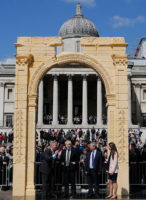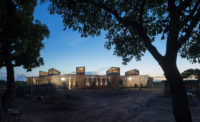College of Charleston Dixie Plantation
A Walk in the Woods: An ecologically diverse former plantation becomes an outdoor classroom.




















Architects & Firms
Hollywood, South Carolina
In 1962, John Henry Dick underwent what some call a hunter's conversion. That year, Dick'a product of New York high society, with a proclivity for ornithology, big game, and porkpie hats'found himself on a safari face-to-face with a Bengal tiger. As he trained his weapon on the beast, he did something unusual: he hesitated. 'A sense of confused shame engulfed me,' he later wrote. He pulled the trigger nonetheless, but, from that point onward, Dick quit hunting and devoted the remainder of his days to wildlife illustration and environmentalism. The tiger became a rug for his South Carolina estate known as Dixie Plantation and, as he wrote, a memento of 'how long it sometimes takes to grow up.'
'The idea is for the whole master plan to be didactic,' says firm principal Adam Gross. 'The property itself teaches about the importance of conservation and sustainability.'
The initial challenge of Dick's gift was in resolving how to utilize it. When the college approached Ayers Saint Gross to discuss options for programming, the site had sat fallow for decades, choked by invasive plants and plagued by illegal hunting'and worse: in 2002, a corpse was discovered in the woods alongside its gravel road.
After discussions with the college and environmental experts, Ayers Saint Gross conceived a three-phase plan to rehabilitate the overgrown property by adding a 4.3-mile nature trail, educational facilities, and water service. When it came to planning classrooms and research spaces, the designers exercised restraint, reserving only 2 percent of the property for building. 'It was ultimately modeled on a rustic camp,' says Gross.
On a recent drizzly morning, Gross and several faculty members strolled along a segment of the wooded walkway. Near the trailhead they came to Dixie's primary structure'a large meeting hall facing the river. The two-story gabled hall has a timber frame and truss roof, echoing a barn that once stood on the site. 'Context, proportion, and scale all mattered,' says Gross, 'so we took the dimensions and proportions of the original barn and developed this new building.' The western elevation is covered by a generous overhang, while the eastern side has a two-level screened porch complete with rocking chairs and tranquil views of the wetlands and river. Inside, a vestibule leads into a full-height open space with a mezzanine level. Its walls are paneled in honey-colored cypress, the floor covered in reclaimed pine, and the windows and doors framed in mahogany.
A short distance from the meeting barn is Dick's former painting studio'a low brick building that the firm also renovated with vernacular materials'which functions as a gallery for Dick's wildlife illustrations, among its other purposes.
The firm planned the meandering trails to wind through a maximum number of ecosystems, with as little impact on the site as possible. (The designers worked closely with conservation and planning firm Biohabitats.) A boardwalk, made from southern pine planks supported by pine timbers on a compacted stone-aggregate base, takes visitors through connected saltwater, brackish, and freshwater ponds. Egrets and blue herons frequently fly up from the marsh amid reeds and cypress trees. Signage and way-finding elements, also designed by Ayers Saint Gross, differentiate the five different zones: meadow, wetland, river, woodland, and an all'e of moss-laden oaks that were part of the original plantation design. Other markers provide historical information, including the history of slaves that farmed the plantation in the antebellum era, and point out specific ecological features, such as habitats for wading birds. 'The thing that is so cool is how the path unfolds,' Gross says. 'It's like a beautiful street along which there are a series of piazzas.'
The trails, barn, and studio are just the start of the transformation: forest remediation tactics, including prescribed burning; the removal of invasive plants; and reforestation (including the planting of 73,000 Longleaf pine seedlings) are under way. This January, two new research stations included in Ayers Saint Gross's master plan, but designed by Johnston Design Group, will be completed to host classes in subjects ranging from archaeology to zoology. Eventually, the campus will also include housing.
Along the trail, two students stooped in a garden, weeding and mulching at the edge of the new path. Carmen Ketron, who is working toward a double master's in environmental studies and public administration at the college, gestured to a pair of plastic kiddie pools filled with a grasslike plant'an experiment in growing Carolina Gold and Charleston Gold rice, varieties once cultivated at the plantation. 'It's really great to have this resource,' she said. 'The students want to get their hands dirty.'
PeopleOwner: College of Charleston
Architect:
Personnel in architect's firm who should receive special credit: Interior designer: Ayers Saint Gross
Engineers:
Structural: Lighting: DWG Engineering, Ayers Saint Gross
Other:
Cost Estimating:
General contractor:
Photographer(s):
Aerials - Construction cost: $4.1 million Size: 881 acres; 3,900 square feet (meeting barn); 1,125 square feet (studio) Completion date: July 2013 |
Products
Structural system
Heavy Timber Roof Trusses and Purlins: Atlantic Specialty Truss
Exterior cladding Porch Flooring: Ipe. Bronze Insect Screen: Screen Technology Group, Inc. Moisture barrier: Henry Company.
Exterior Paving Flexible Porous Pavement: Gravelpave 2, Invisible Structures, Inc.
Roofing
Windows
Doors Interior doors: Mahogany Stile and Rail Doors
Hardware Closers: Corbin Russwin Architectural Hardware Exit devices: Corbin Russwin Architectural Hardware Pulls: Rockwood Manufacturing Co.
Interior finishes Suspension grid: USG Interiors Cabinetwork and custom woodwork: Peralta Woodworks, Inc. Paints and stains: The Sherwin-Williams Company; Messmer’s Natural Wood Finishes Wall Paneling, Meeting Barn: Southern Cypress; Trim, Studio: Mahogany. Wood Flooring: Rift Grade Historic Heart Pine Engineered Flooring (reclaimed), Mountain Lumber Company Granite: North Carolina Granite Corporation Floor and wall tile: Daltile Corporation (restrooms, kitchen) Stone flooring: Slate flooring, Studio – Vermont Structural Slate Company, Inc.
Specialties
Furnishings
Lighting
Exterior: Dimming System or other lighting controls: Lutron.
Plumbing
Energy |















